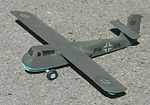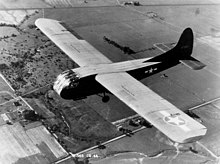User:The Bushranger/Glide
This is a complete list of Second World War military gliders. Only vehicles that reached at least the prototype stage are included in this list.
Aircraft[edit]
| Aircraft | Illustration | Origin | Type | First flight | Entered service | Number built | Notes |
|---|---|---|---|---|---|---|---|
| de Havilland Australia DHA-G1 | Australia | Transport | June 1942 | - | 2 | Prototype transport, six-passenger capacity.[1] | |
| De Havilland Australia DHA-G2 | Australia | Transport | March 1943 | May 1943 | 6 | Improved version of DHA-G1; used as a trainer.[1] | |
| Blohm & Voss BV 40 |  |
Germany | Fighter | May 1943 | - | 6 | Heavily armored bomber destroyer. Orders for 200+ cancelled.[2] |
| Blohm & Voss BV 246 |  |
Germany | Bomb | 1943 | - | c.1,000 | Original guided-bomb version cancelled due to success of V-1; reinstated as an anti-radar weapon but not used operationally.[3] |
| DFS 230 |  |
Germany | Transport | 1937 | 1938 | 1,600+ | Standard Luftwaffe troop transport glider; nine-passenger capacity.[4] |
| DFS 331 | Germany | Transport | September 1940 | - | 3 | Heavy transport prototype; twenty-passenger capacity. Cancelled in favor of Go 242.[5] | |
| Gotha Go 242 |  |
Germany | Transport | 1941 | 1941 | 1,528 | Standard Luftwaffe heavy transport glider; 23-passenger capacity.[6] |
| Gotha-Kalkert Ka 430 |  |
Germany | Transport | March 1944 | - | 12 | Intended replacement for DFS 230; 12-passenger capacity.[7] |
| Messerschmitt Me 321 |  |
Germany | Transport | February 1941 | May 1941 | 200 | Very heavy transport; 130-passenger capacity.[8] |
| Junkers Ju 322 |  |
Germany | Transport | April 1941 | - | 2[N 1] | Very heavy transport prototype.[9] |
| Hindustan Aircraft G-1 | India | Transport | 1942 | - | 1[N 2] | Very heavy transport prototype.[1] | |
| Aeronautica Lombarda AL-12P | Italy | Transport | 1943 | - | 16 | 16-passenger capacity.[10] | |
| C.A.T. TM-2 | Italy | Transport | 1939 | - | 1 | Prototype with 10-to-20-passenger capacity.[1] | |
| Kimura HK-1 | Japan | Experimental | 1939 | 1 | Tailless aircraft research prototype, acquired by IJAAF in 1940.[11] | ||
| Maeda Ku-1 | Japan | Trainer | January 1941 | September 1941 | 100 | Twin-boom training/transport glider, 8-passenger capacity.[12] | |
| Kayaba Ku-2 |  |
Japan | Experimental | October 1940 | - | 1 | Tailess aircraft research prototype.[11] |
| Kayaba Ku-3 | Japan | Experimental | February 1941 | - | 1 | Tailess aircraft research prototype.[11] | |
| Kokusai Ku-7 |  |
Japan | Transport | 1942} | - | 2 | Experimental twin-boom tranport. 32-passenger/1 light tank capacity.[13] |
| Kokusai Ku-8 |  |
Japan | Transport | 1942} | 1942 | 700 | Standard Japanese transport glider; 20-passenger capacity.[14] |
| Yokosuka MXY5 |  |
Japan | Transport | 1942 | - | 12 | Prototype 11-passenger transport.[15] |
| Yokosuka MXY6 |  |
Japan | Experimental | 1943 | - | 3 | Proof of concept for Kyushu J7W.[16] |
| Yokosuka MXY8 |  |
Japan | Trainer | December 1944 | 1945 | 50 | Trainer for Mitsubishi J8M. IJAAF designation Ku-13.[17] |
Soviet Union[edit]
- Antonov A-7 (RF-8), 8 troops, 400 (approx) produced [1]
- Antonov A-40, flying tank, prototype
- BDP (S-1) glider, 20 troops, 7 built.[1]
- Gribovski G-11, 11 troops, about 100 built[18]
- KT-20 glider, 24 troops, 1 or possibly 2 built.[1]
- SAM-23 glider, 16 troops or a vehicle.[1]
- TS-25 glider, 25 troops or a vehicle. 6 built.[1]
Sweden[edit]
- AB Flygindustri FI-3, 11 troops, 5 built.[1]
Turkey[edit]
- THK-1 glider, 11 troops, prototype.[1]
United Kingdom[edit]
- Airspeed Horsa, 25 passengers and 2 crew or equivalent weight of cargo including small vehicles. 3,655 built.
- Baynes Bat, (1943) experimental glider for testing design of a tank carrying glider
- General Aircraft Hamilcar, (1942) 7 t (6.9 long tons) of cargo and 2 crew. 412 built.
- General Aircraft Hamilcar Mk. X, Motorised version with 2x Bristol Mercury 31 of 965 hp. 22 examples converted
- General Aircraft Hotspur, trainer 8 passengers and 2 crew. more than 1,000 built.
- Slingsby Hengist, 15 passengers and 1 crew. 18 built.
United States[edit]

- Allied Aviation XLRA
- Cornelius XFG-1, fuel carrier, 2 prototypes
- St Louis CG-5 prototype only
- Waco CG-3
- Waco CG-4A Hadrian, 13 troops and 2 crew. More than 12,000 built., known in US Navy service as "Waco LRW-1"
- Waco CG-13A
- Waco CG-15
- General Airborne Transport XCG-16A
- Bristol XLRQ Amphibious assault glider[19]
- Douglas XCG-17 - prototype based on de-engined C-47 Skytrain.
- Laister-Kauffman XCG-10A "Trojan Horse" - Large Transport Glider. Some confusion as to the differences between the XCG-10 and the XCG-10A. 2 prototypes built and flown.[20]
- Pratt-Read LBE
- Piper LBP
- Piper LNP
- Taylorcraft LBT
- Taylorcraft LNT
- Pratt-Read TG-32
- Schweitzer LNS
See also[edit]
References[edit]
Notes[edit]
Citations[edit]
- ^ a b c d e f g h i j k Wood, Alan (1990). History of the World's Glider Forces. Patrick Stephens Limited. ISBN 978-1852602758.
- ^ Donald, David (1997). The Complete Encyclopedia of World Aircraft. London: Orbis Publishing. pp. 143–144. ISBN 0-7607-0592-5.
- ^ Lepage, Jean-Denis G. G. (2009). Aircraft of the Luftwaffe 1935-1945. Jefferson, NC: McFarland & Company. p. 67. ISBN 978-0-7864-3937-9.
- ^ Green, William (2010). Aircraft of the Third Reich (1st ed.). London: Aerospace Publishing Limited. pp. 136–144. ISBN 978-1-900732-06-2.
- ^ Griehl, Manfred (2012). X-Planes: German Luftwaffe Prototypes 1930-1945. London: Frontline Books. ISBN 978-1-783034-19-2.
- ^ Donald 1997, p.462
- ^ Lepage 2009, p.357
- ^ Donald 1997, p.625
- ^ * Smith, J.R. and Anthony L. Kay. German Aircraft of the Second World War. London: Putnam and Company Ltd., 1972 (3rd imp. 1978). p. 446-448. ISBN 0-370-00024-2
- ^ Mrazek, James E. (2011). Airborne Combat - The Glider War/Fighting Gliders of WWII. Mechanicsburg, Pennsylvania, United States: Stackpole Books. ISBN 978-0-8117-0808-1.
- ^ a b c Wooldridge, E. T.; National Air and Space Museum (1983). Winged wonders: the story of the flying wings. Washington, DC: Smithsonian Institution Press. p. 85. ISBN 978-0874749663.
- ^ Mrazek 2011, p.344
- ^ Rottman, Gordon L.; Akira Takizawa (2005). Japanese Paratroop Forces of World War II. Elite. Vol. 127. Botley, Oxford: Osprey Publishing. p. 12. ISBN 978-1-84176-903-5.
- ^ Rottman and Takizawa 2005, p.12-13.
- ^ Air Pictorial 1959, p.267.
- ^ Francillion 1979, p. 336.
- ^ Francillon, René J. Japanese Aircraft of the Pacific War. London: Putnam & Company Ltd., 1970 (2nd edition 1979). pp. 404-407. ISBN 0-370-30251-6.
- ^ Gunston, Bill (1995). The Osprey Encyclopedia of Russian Aircraft 1875-1995. London: Osprey (Reed Consumer Books Ltd). p. 82. ISBN 1 85532 405 9.
- ^ Popular Science, May 1943, An Amphibian Glider
- ^ Daves WarbirdsAero Web
